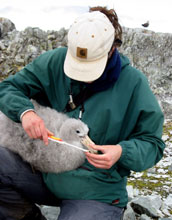Multimedia Gallery
Measuring Bill of Giant Petrel Chick
Biologist Heidi Geisz measures the bill length of a giant petrel chick. Scientists have been monitoring the giant petrel population near Palmer Station, Antarctica, since the 1970s.
The National Science Foundation-supported Palmer Long-Term Ecological Research Project (PAL LTER) monitors western Antarctic Peninsula ecosystems annually over a grid of oceanographic stations and seasonally at Palmer Station. Giant petrels lay one egg every year and nest on the same island with the same mate. Both males and females care for the egg and chick. They eat carrion, squid, fish, krill and baby penguin chicks.
The Antarctic Conservation Act (Public Law 95-541) formalizes U.S. adherence to all Antarctic Treaty conservation rules. Participants must obtain a permit to go into specially protected areas as well as to be in close proximity to wildlife. For more information on the Antarctic Conservation Act, visit http://www.nsf.gov/od/opp/antarct/aca/aca.jsp. (Date of Image: March 15, 2004)
Credit: Photo by Katy Jensen, National Science Foundation
Images and other media in the National Science Foundation Multimedia Gallery are available for use in print and electronic material by NSF employees, members of the media, university staff, teachers and the general public. All media in the gallery are intended for personal, educational and nonprofit/non-commercial use only.
Images credited to the National Science Foundation, a federal agency, are in the public domain. The images were created by employees of the United States Government as part of their official duties or prepared by contractors as "works for hire" for NSF. You may freely use NSF-credited images and, at your discretion, credit NSF with a "Courtesy: National Science Foundation" notation.
Additional information about general usage can be found in Conditions.
Also Available:
Download the high-resolution JPG version of the image. (452 KB)
Use your mouse to right-click (Mac users may need to Ctrl-click) the link above and choose the option that will save the file or target to your computer.



